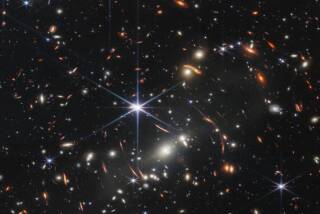UCSD Scientists Cheer Launching
- Share via
It won’t really be working for another eight months, but the Faint Object Spectrograph included in the Hubble Space Telescope still got an enthusiastic send-off Tuesday from a dedicated cadre of UC San Diego scientists and engineers.
“We were just elated. It was a real thrill,” said William A. Baity, the science program manager for the spectrograph project, in a telephone interview after the Florida launch.
Baity and about 2 dozen others involved over the years at University of California, San Diego’s Center for Astrophysics and Space Sciences babied the Faint Object Spectrograph into existence. It was a task that has taken more than two decades.
The spectrograph was conceived in the 1960s, designed beginning in the early 1970s, and modified after the Challenger disaster moved the launch date from 1986 to 1990.
Like others involved in the space telescope project, the UCSD researchers were disappointed by delays in the telescope’s launch and buoyed by Tuesday’s success, Baity said.
For about three minutes, though, the crowd of VIP guests watching the launch worried that their waiting would continue, as the launch countdown was halted at 31 seconds by a last-minute mechanical problem aboard the shuttle.
“There was a lot of nervous chatter before, but when they announced the problem it just became deathly quiet, and stayed that way,” Baity said. “You just can’t believe how quiet several thousand people can get.”
The spectrograph will be used to separate the light from faint objects into its various wavelengths, from ultraviolet through the visible spectrum and into the near-infrared. These measurements reveal information that includes how far away a star or other object is, what chemical elements are in it and whether it is moving toward or away from Earth.
Spectra are a valuable part of ground-based observations, but the Earth’s atmosphere limits them.
UCSD researchers not only designed and oversaw construction of the Faint Object Spectrograph, but also developed all the software for controlling and collecting data from it.
Because of their key role, UCSD astronomers are guaranteed observation time on the spectrograph. It will only be operable about 35% of the time because of orbital and mechanical limitations.
Much of their observing time will go to quasars, the most distant and energetic objects in the universe, to try to understand their workings and evolution.
Other researchers at UCSD involved include:
* E. Margaret Burbidge, a noted astronomer who is principal investigator for analyzing the spectrograph’s data.
* Edward Beaver, a research physicist and co-inventor of a revolutionary type of photon detector used in the spectrograph. The other inventor is Carl McIlwain, a UCSD physics professor.
* Lawrence K. Randall, director of the spectrograph engineering team.
If all goes well with deploying the telescope today, the instrument test team that Randall heads will spend the next 90 days slowly testing each component.
“Essentially, we turn everything on in a very precise and preprogrammed order and see if it works,” Randall said before the launch.
The first step, 5 1/2 hours after launch, was to turn on heaters that assure that the spectrograph can work in the frigid space environment. An electrical check will come today, and, by the 20th day after launch, 23,000 volts of electricity will be turned on.
“We’ll step up the voltage in 11 steps over 11 orbits, turning it on for two minutes, then off, and sending a bigger jolt each time,” Baity said.
By Day 50, the spectrograph will look at its first celestial object, NGC188, a star cluster in the Milky Way--but only as a test. Science verification, the time during which all instruments are tested, will begin after three months and continue until December.






